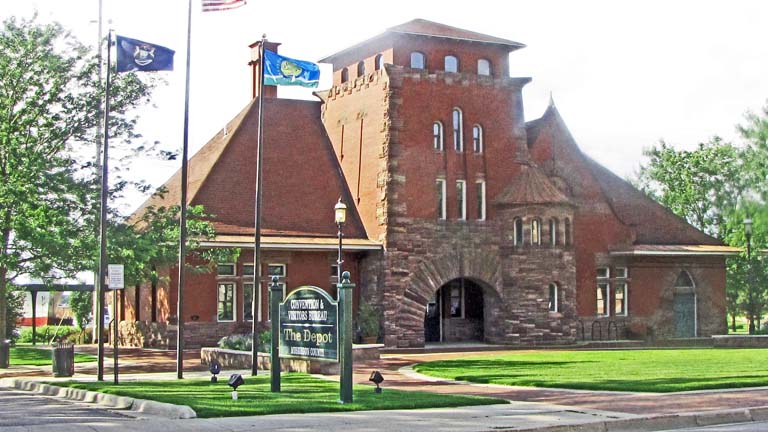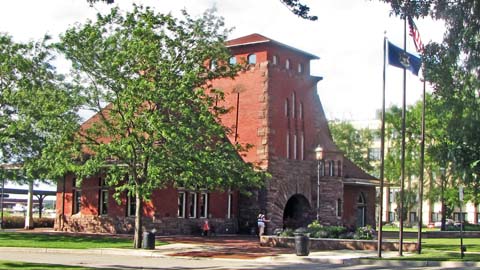

This is my favorite example of the Richardson Romanesque style as an inspiration for a railroad depot in Michigan. There are other Richardson Romanesque depots, each with their own appealing elements. The Michigan Central depot that Frederick Spier and William Rohns designed for Ann Arbor is extremely nice but my favorite is the one pictured above because of its unusual styling.
Muskegon was one of many Michigan cities that boomed in the last one-third of the Nineteenth Century because of the state’s white pine forests. Timber was cut north of Muskegon and then shipped by water or rail to the city for processing. Lake Muskegon provided a very safe harbor so Muskegon became a significant port when water was the most economical way to ship throughout the Great Lakes region. At one point in the decades after the Civil Wasr, Muskegon had 47 mills processing lumber. The success of those mills and the skilled craftsmen working in them led the city to become a vibrant manufacturing hub turning out a great variety of products including some you would not expect to find there. Just as it is surprising to learn that Detroit was had a flourishing tobacco industry, so to it is surprising to learn about the dominant role that Muskegon’s huge Amazon mills played in the nation’s hosiery industry. Indeed, the mammoth Amazon mill, dating from 1895 with its two gigantic towers, still looms over Muskegon’s Union Station. The Amazon Mill has been converted into apartments or condominiums.
the city to become a vibrant manufacturing hub turning out a great variety of products including some you would not expect to find there. Just as it is surprising to learn that Detroit was had a flourishing tobacco industry, so to it is surprising to learn about the dominant role that Muskegon’s huge Amazon mills played in the nation’s hosiery industry. Indeed, the mammoth Amazon mill, dating from 1895 with its two gigantic towers, still looms over Muskegon’s Union Station. The Amazon Mill has been converted into apartments or condominiums.
In the mid-Nineteenth Century, cities—even very small ones—sought railroads so that goods and people could economically come and go. Many cities gave land to railroads or promised to buy the railroad’s bonds if they would construct a line. In the pre-Civil War era, however, many railroads went short distances to link a city to its own immediate hinterland from one city to a nearby location. Gradually that changed, and by 1871, the Michigan Lake Shore connected Muskegon to Chicago. Later, two other lines linked Muskegon to Grand Rapids, the east side of Michigan and other points.
Toward the end of the Nineteenth Century, city officials realized that there was a substantial liability to having three or more rail lines in their locale. Every line had its own yards, its own maintenance shops, its own freight facilities and its own depot. Going from one side of town to the other or passing through downtown meant crossing many rail lines where you would not only be delayed by trains moving with the speed of a tortoise but covered by soot from a coal burning engine. And a passenger who wished to pass through a city to get from one point to another often had to travel from one line’s depot to another. Large and small towns suggested that the railroads should pool their facilities so as to improve traffic flow and cut down on the nasty pollution produced by burning soft coal. One key element in this was the building of a Union Depot that would serve some or all of the passenger railroads in the city. For a variety of reasons—most financial—railroads were often reluctant to help construct a union depot but some cities were successful in their efforts. Union depots were erected in Michigan cities as small as Clare and Mackinac City.
By the 1890s, the Michigan Lake Shore Railroad had become the Chicago and West Michigan with lines reaching north to Petoskey along the east shore of Lake Michigan. Another railroad—the Muskegon, Grand Rapids and Indiana—linked Muskegon to Grand Rapids.
That line was controlled by the Grand Rapids and the Grand Rapids and Indiana whose main line was completed north from Richmond, Indiana to Mackinac City in 1883. This line was controlled by the Pennsylvania Railroad. The branch from Grand Rapids to Muskegon was completed in 1886. These two railroads joined to build the fascinating depot that you see pictured here. A third railroad in Muskegon at that time was the Toledo, Saginaw and Muskegon with a line east to Ashley, Michigan. This line became a component of the Grand Trunk Western. I do not know if they ever used the Muskegon Union Station. In the 1920s, they built their own depot about two blocks away from the station pictured above, a depot that still stands. did not join in the movement to establish a Union Depot.
In 1899, the Pere Marquette Railroad was formed from several large Michigan lines that stretched across very much of the state. The Chicago and West Michigan was incorporated into the Pere Marquette, and in that year, the Pere Marquette took over operation of the depot. Interestingly, this depot was at the end of two branch lines, one going to Grand Rapids and the other to Holland where the Pere Marquette’s mail line from Detroit to Chicago through Grand Rapids was located. This station was not heavily used and by the 1920s, both of the lines using it were down to just a few trains every day. Nevertheless, the Chesapeake and Ohio Railroad, the line that purchased the Pere Marquette in 1927, offered two round trips every day to Chicago until the emergence of Amtrak on April 1, 1971.
Work on this depot began in 1893 with Sidney J. Osgood as the architect. Born in Maine, he studied architecture in Boston and then came to Grand Rapids to establish his practice. He was a popular architect and designed numerous western Michigan structures. This depot is his most outstanding remaining structure, but he also designed the Richardsonian Romanesque court house that serves Mason County in Ludington. He was also the architect for a more humble but very appealing Grand Rapids and Indiana depot in Harbor Spring. The severe recession of 1893 halted many projects and sent numerous rail lines, including the Ann Arbor, into bankruptcy. Work on the Muskegon Union depot halted. Quickly, however, there was a resumption of construction but the architect for the completion was A. W. Rush, also from Grand Rapids. Rush, presumably, had the obligation of reducing the size of the depot to keep it within budget because of the financial crisis of that decade. Nevertheless, he designed a beautiful structure. Note the unusual tapering four-story tower reaching about the two-story depot with its steeply pitched roofs. If you get an opportunity to walk around this depot, you will see that the red brick is very attractively offset with red and cream sandstone obtained from the Marquette area. Note the circular arch with its portico covering the enterance. Next to the tall tower, you see a circular stair tower that has its own appeal.The depot opened for trains on September 22, 1895.
The Pere Marquette railroad was taken over by the Cheseapeake and Ohio in 1947. They continued to offer passenger service to Chicago until Amtrak took over most rail passenger service on May 1, 1971. The Pennsylvania Railroad terminated their passenger service to Muskegon decades earlier. After the demise of rail passenger service to Muskegon, the depot was idle for twenty years. I believe an entrepreneur intended to convert the depot into a furniture store and showroom but those plans were not completed. In 1990, Muskegon County acquired the structure and gradually, it was restored to its original elegance including a very large brick fireplace and maple floors. Personally, I am most impressed by the unusual and massive entrance. Passing through this overwhelming stone entrance certainly reminds you that you are making a transition from one location to another. This building now serves as a visitors' center for Muskegon with offices and conference rooms on the upper floor.
Very attractive pictures of this depot and most information are provided in the book noted below.
The name Muskegon is, I believe, an anglicanization of a French interpretation of the Indian word for marshy river. French explorers visited this area in the early 1700s, but did not establish a military post or trading post at what we now know as Lake Muskegon. Lewis B. Baddeau established a trading post here in 1834 and Joseph Troutier came the next year to trade. The French used the word Masquignon for the river that emptied into Lake Michigan at this point. At some point in the Nineteenth Century, that was changed to Muskegon.
Date of opening: September 22, 1895
Architects: Sidney J. Osgood for the early design. A. W. Rush for the completion of the project
Architectural Style: Richardson Romanesque
For more information see: Michael H. Hodges, Michigan’s Historic Railroad Stations. Detroit: Wayne State University Press, 2012
Use in 2013: Muskegon County Convention and Visitors Bureau
Website for current occupants: www.visitmuskegon.org
State of Michigan Registry of Historic Sites: P24,301; Listed: May 17, 1978
State of Michigan Historic Marker: Erected: February 28, 2000
National Register of Historic Places: #00001489 Listed December 7, 2000
Photograph: Ren Farley; June 28, 2011
Description updated: February, 2013